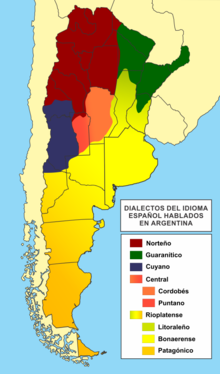variant of Spanish spoken in Argentina and Uruguay From Wikipedia, the free encyclopedia
Rioplatense Spanish (/ˌriːoʊpləˈtɛnseɪ/),[2] also known as Rioplatense Castilian, is a variety of Spanish.[3][4][5]
| Rioplatense Spanish | |
|---|---|
| Argentine–Uruguayan Spanish | |
| Español rioplatense (Español argentino-uruguayo) | |
| Pronunciation | [ehpaˈɲol ri.oplaˈtense] |
| Native to | Argentina, Uruguay |
| Dialects | Outer Dialects: Norteño (Northern) Guaranítico (Northeastern) Cuyano (Western) Cordobés (Central) Inner Dialects: Litoraleño (Coastal) Bonaerense (Eastern) Patagónico (Southern) Uruguayan |
| Latin (Spanish alphabet) | |
| Official status | |
Official language in | |
| Regulated by | Academia Argentina de Letras Academia Nacional de Letras de Uruguay |
| Language codes | |
| ISO 639-1 | es |
| ISO 639-2 | spa[1] |
| ISO 639-3 | – |
| Glottolog | None |
| IETF | es-AR |
 Spanish dialects in Argentina | |
It is spoken mainly in and around the Río de la Plata Basin of Argentina and Uruguay.[6] It is also referred to as River Plate Spanish or Argentine Spanish.[7]
It is the most prominent dialect to employ voseo in both speech and writing. Many features of Rioplatense are also shared with the varieties spoken in south and eastern Bolivia, and Paraguay.
This dialect is often spoken with an intonation resembling that of the Neapolitan language of Southern Italy, but there are exceptions.
Seamless Wikipedia browsing. On steroids.
Every time you click a link to Wikipedia, Wiktionary or Wikiquote in your browser's search results, it will show the modern Wikiwand interface.
Wikiwand extension is a five stars, simple, with minimum permission required to keep your browsing private, safe and transparent.